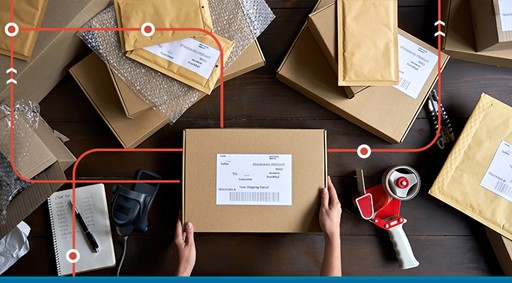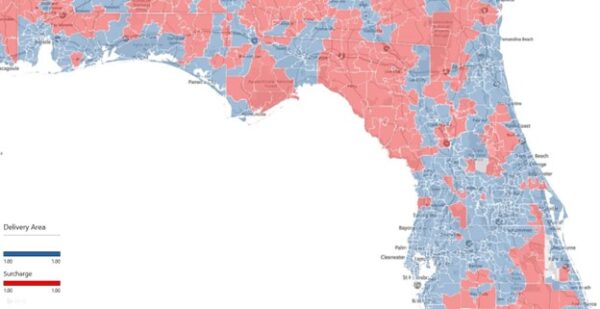What is a Delivery Area Surcharge?
Most shipping carriers charge additional fees called assessorial or surcharges to account for packages that have additional costs to handle. One of the most common of these surcharges is the Delivery Area Surcharge, often referred to as DAS. This surcharge was created in 1999 after an industry consultant published a detailed research report on the significant cost differences in servicing urban, suburban, and rural areas. FedEx and UPS quickly embraced the analysis and began charging the surcharge according to the consultant’s recommendation of using zip codes to target these “higher” cost to service areas. USPS typically does not assess any rural surcharges as their federal charter requires them to have a postal facility in rural areas to facilitate reliable mail delivery to all citizens in the United States.
What Zip Codes Get Assessed the Fee and How Is the Surcharge Calculated?
DAS surcharges are applied to both deliveries and pickups that fall outside of the shipping carriers’ “standard area” of shipping. The carriers have the discretion to set these areas themselves and they are often updated yearly via a published list. Carriers determine the applicability of DAS fees based on a range of factors, including geographical considerations, population density, infrastructure accessibility, and operational costs. Extended delivery areas, typically located in remote or less densely populated regions, often incur higher handling and transportation expenses due to increased distance and/or lower shipment volumes. Similarly, these remote areas may have challenging terrain necessitating special delivery methods, further contributing to elevated operational costs to the carriers. The specific criteria for defining these regions may vary among carriers, but typically encompass ZIP code classifications, distance from distribution centers, and historical shipping data. By incorporating these factors into their DAS calculations, carriers aim to accurately reflect the additional costs associated with servicing specific geographical areas ensuring equitable pricing for their services.
2024 Published DAS Lists
One important note is that while a DAS fee is the most common surcharge for rural delivery areas, carriers can also assess Extended Delivery Area surcharges to very remote areas within the US and even more expensive Remote Area Surcharges to the non-contiguous States of Alaska and Hawaii.
 Both FedEx and UPS have standard published rates for each Delivery Area Surcharge. 3PL’s like 5 Logistics, however, typically have negotiated discounts on these surcharges. For example, FedEx’s 2024 Ground DAS published fee is $5.85 per package, but shipping with 5 Logistics’ house account you’ll likely only pay 50-60% of that total. There are also different rates on Express shipments averaging $1-$2 more per package.
Both FedEx and UPS have standard published rates for each Delivery Area Surcharge. 3PL’s like 5 Logistics, however, typically have negotiated discounts on these surcharges. For example, FedEx’s 2024 Ground DAS published fee is $5.85 per package, but shipping with 5 Logistics’ house account you’ll likely only pay 50-60% of that total. There are also different rates on Express shipments averaging $1-$2 more per package.
It’s also important to factor in the dimensions and weight of your parcels when calculating DAS fees. Shipping companies often impose extra charges for packages that exceed standard size and weight limits because overweight and oversized packages require more space and resources to transport. Optimizing packaging to reduce package dimensions and weight can help to mitigate these fees.
 How Often is the Delivery Area Surcharge Assessed?
How Often is the Delivery Area Surcharge Assessed?
The percentage of shipments that get hit with DAS fees varies from year to year, but the shipping industry approximates that 20% of packages that go thro
ugh the network get hit with some variation of these fees. There are approximately 42,000 zip codes in the US and over 25,000 of them fall under some sort of DAS assessment.
How to Avoid DAS Fees?
There are several strategies to avoid DAS Fees. Below are the most strategies common that 3PL’s utilize on behalf of their clients.
- Implement dynamic pricing in the Shopify cart to capture additional shipping charges at the time of check-out based on the recipient’s address and zip code.
- Switch to USPS when shipping to residential addresses. USPS does not assess these fees on packages and their shipping speeds have gotten better since the transition to Ground Advantage last year.
- Use best rate shipping codes of other intelligent shipment routing tools to flag these shipments before calling for the shipping label.
- Utilize flat-rate shipping services.

DAS Example Map (Blue = no surcharge, Red = Surcharge)
Navigating future Trends in DAS Fees and Shipping Surcharges
Looking ahead, it’s crucial to consider the potential future trends and developments shaping the landscape of DAS fees and shipping surcharges. Advancements in shipping technology, such as the integration of automation, artificial intelligence, and predictive analytics, are poised to revolutionize logistics operations. These innovations have the potential to enhance carrier efficiency, optimize route planning, and mitigate costs associated with last-mile delivery, thereby impacting the calculation and application of DAS fees. Moreover, shifts in consumer behavior, driven by factors such as the rise of e-commerce, sustainability concerns, and demand for expedited delivery options, may influence carrier strategies and pricing models. By anticipating these future trends and staying abreast of evolving market dynamics, businesses can proactively adapt their shipping strategies to remain competitive and effectively manage DAS fees in the years to come.
Conclusion
Since shipping costs can account for a significant portion of an eCommerce company’s budget, optimizing strategies to minimize surcharges like the Delivery Area Surcharge becomes paramount for maintaining profitability and competitiveness for online retailers. By understanding the factors that influence these fees, implementing efficient shipping practices, and leveraging partnerships with 3PLs like 5 Logistics, businesses can navigate the complexities of shipping surcharges while ensuring cost-effective and reliable delivery services for their customers.
 5 Logistics
5 Logistics